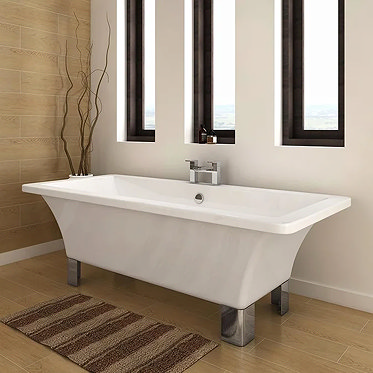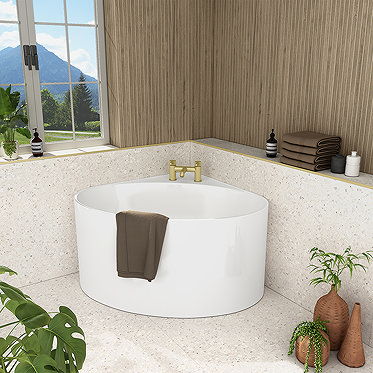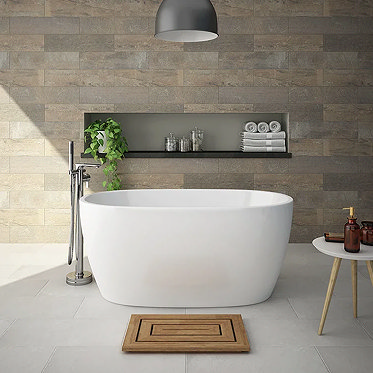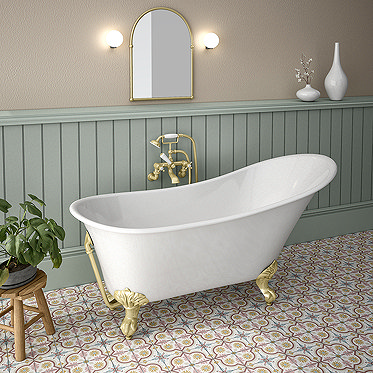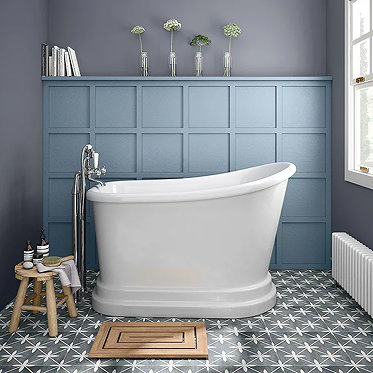UP TO 60% OFF SPRING SALE!
Free Delivery on Orders Over £499**
Freestanding Baths Buying Guides
Freestanding Baths Buying Guides
Buying A Freestanding Bath - Everything You Should Know
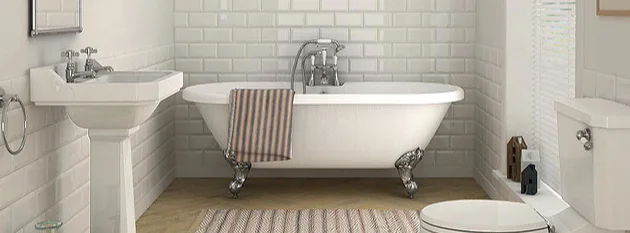
Freestanding bathtubs are a stunning focal point in any bathroom—combining elegance, versatility, and an unmistakable “wow factor.” Modern freestanding tubs come in a wide variety of shapes and materials, from lightweight acrylic to luxurious copper or cast iron. This expert buying guide brings together everything you need to know about selecting, installing, and caring for a freestanding bath: from first-time buyer basics to advanced tips on materials, design, and maintenance.
Click Below to Jump to a Section
For First-Time Buyers: A Quick Overview
Savvy Shopper: Advanced & Technical Tips
- Comparison of Materials
- Size & Dimensions
- Style & Aesthetic Preferences
- Who Will Use the Bath (Intended Use & Users)
- Budget & Price Ranges
- Our Top Freestanding Bath Brands
- FAQs & Final Thoughts
For First-Time Freestanding Baths Buyers
A Quick Overview
A freestanding bath is a bathtub that stands independently of walls or built-in frames, with all four sides finished. Because it can be placed nearly anywhere in the room (space permitting), a freestanding tub instantly becomes a visual centerpiece that sets the tone for your bathroom design.
The Appeal of Freestanding Baths
Freestanding baths are a striking focal point that instantly add luxury and style to any bathroom. Their versatility allows for flexible placement—you’re not restricted to corners or alcoves, so you can position the tub under a window, at an angle, or even in the center of the room for maximum impact. Beyond functionality, freestanding tubs also elevate bathroom aesthetics, seamlessly complementing a range of styles, from sleek modern designs to timeless, ornate clawfoot models.
Space & Positioning Basics
Measuring Your Bathroom
- Carefully measure your floor area, door widths, and any narrow hallways or stairs the tub must pass through.
- Leave at least 4 inches (10 cm) of space between the tub and walls or fixtures—more if you have the room (some designers suggest 12 inches for a truly “free” look).
- Consider the tub’s overall footprint plus clearance so you can clean around and behind it.
Floor Support
- Check the structural integrity of your floor. Large, heavy tubs (cast iron, stone, copper) filled with water can weigh hundreds of kilograms.
- An upstairs bathroom may need reinforced joists to support the load safely.
Placement & Visual Flow
- Decide whether you want your tub as the central highlight or if it will be tucked near a window or wall.
- Ensure plenty of manoeuvring space for you—and for any future maintenance.
Key Performance Factors & Compatibility
When choosing a freestanding bath, there are several key factors to consider. Comfort and soaking depth vary between models, so it's worth physically "test-sitting" a display bath to ensure the height, shape, and internal contour suit your preferences. Water heater capacity is another important aspect—a larger or deeper tub may require more hot water than your heater can supply at once, potentially leading to lukewarm baths. Additionally, plumbing layout plays a role in installation. Freestanding baths can have the drain positioned at one end, as seen in slipper tubs, or centrally placed in double-ended styles. In many cases, re-routing plumbing is necessary to accommodate your chosen design.
So, what are your options?
Types of Freestanding Baths
Feet and plinths
Some freestanding baths sit directly on the floor, while others are raised, adding an extra layer of visual interest. Certain designs feature a subtle nod to vintage claw-foot styles, offering a refined twist on classic elegance. Others rest on stylish wooden plinths, creating a unique, bespoke look that enhances the bath’s presence in the room. Whether you prefer a sleek, modern base or a more decorative, raised design, the right choice will depend on your personal style and the overall aesthetic of your bathroom.
For Savvy Freestanding Bath Shoppers
Size & Dimensions
Freestanding tubs are available in various lengths and widths—commonly 55″ to 72″ long (140–183 cm) and 27″ to 32″ wide (69–81 cm). Depth to overflow can range 14″ to 20″ for a proper soak.
- Compact Tubs (~48–55″/120–140 cm)
Ideal for smaller bathrooms. Slipper shapes can be surprisingly comfy despite the shorter length. - Standard Tubs (~60″/5 feet)
Accommodates most adults in a typical soak; holds around 40–60 gallons (150–230 liters). - Large & Two-Person Tubs (66″–72″ / 167–183 cm or more)
Great for couples or those who want extra depth. Keep in mind the weight and hot water demands.
Tip: Leave a few inches (at least 4″) between the tub and walls/fixtures. Also measure doorways and tight corners for delivery logistics—especially crucial for cast iron or large stone tubs.
Style & Aesthetic Preferences
Your choice of freestanding bath should complement both your personal style and how you plan to use it. If you enjoy long, hot soaks, consider heat-retentive materials like cast iron or stone, which help keep water warm for longer. Slipper baths and deep soaking tubs are designed with comfort in mind, offering an ergonomic shape that supports full-body relaxation.
For a luxurious focal point, double-ended baths provide a bold, symmetrical look while offering a comfortable soak from either side. Traditional clawfoot or pedestal designs add a vintage charm, whereas modern freestanding baths with sleek, sculptural lines create a minimalist aesthetic.
Who Will Use the Bath (Intended Use & Users)
When choosing a freestanding bath, it’s important to consider who will be using it most often. For everyday family use, a durable acrylic or enameled steel bath is a practical choice, as these materials are easy to clean and less prone to chipping. If the bath will be used by children or older adults, opting for a design with a lower rim height can make getting in and out easier.
Mobility concerns should also be factored in, as freestanding baths can be more challenging to step into compared to built-in tubs. A grab bar or floor-mounted handle can add stability, while a walk-in tub or built-in model with integrated handrails may be a safer alternative.
For those looking for a bath designed for two, a double-ended model with a centrally positioned drain and overflow offers the most comfortable option. Ensuring strong floor support is also key for larger, deeper tubs.
Freestanding Baths by Price Range
£500 – £1,000: Affordable Style and Practicality
Freestanding baths in this price range offer stylish yet cost-effective options, perfect for modern bathrooms.
Key Features:
- Durable Acrylic Construction – Lightweight yet sturdy for long-lasting use.
- Modern and Traditional Designs – Available in sleek contemporary styles and classic roll-top options.
- Practical Sizes – Ranges from compact corner baths to spacious double-ended designs.
- In-Built Waste Systems – Many include a waste for added convenience.
- Quick Installation – Designed for easy fitting with minimal plumbing modifications.
Finance options available from £19/month.
£1,000 – £2,000: Mid-Range Elegance
This tier introduces premium materials, improved comfort, and refined aesthetics.
Key Features:
- Solid Stone and Cast Iron Options – Superior heat retention for a longer, warmer soak.
- Elegant Finishes – Gloss white, brushed brass, and matt black for a premium look.
- Whirlpool and Airspa Options – Spa-like indulgence with advanced jet systems.
- Bigger Sizes for Ultimate Comfort – Longer, deeper, and more spacious designs.
Finance options available from £41/month.
£2,000+: The Ultimate in Luxury
For those seeking a show-stopping centrepiece, this range features handcrafted baths in premium materials like copper, nickel, and cast iron.
Finance options available from £75/month for the ultimate indulgence.
Disclaimer: Prices and finance options are correct at the time of writing and may be subject to change. Stock availability varies, so check before purchasing.
Hidden Costs to Consider: Faucets, Drains & Installation
- Faucet & Drain Kit: Floor fillers can be £300–£1,500+ alone.
- Installation: Professional plumbing plus any structural work may add £500–£2,000+ depending on complexity.
Maintenance & Care
To keep your freestanding bath in top condition, regular maintenance is essential. Wiping down the tub after each use helps prevent soap scum and mineral buildup, preserving its pristine appearance. Always use non-abrasive cleaners and soft cloths to avoid damaging the finish, as harsh chemicals can dull or degrade the surface over time. Additionally, it's important to dry the area around the base and floor after use, as standing water or splashes can lead to moisture buildup, which may cause mold or floor damage if left unchecked.
Top Freestanding Bath Brands
- Arezzo: Renowned for sleek, modern lines and premium finishes—perfect for an upscale contemporary look.
- BC Designs: Offers innovative shapes in a range of materials, from classic acrylic to luxurious stone-resin pieces.
- Burlington Bathrooms: Specialises in timeless, traditional styles—ideal for those seeking a vintage aesthetic with modern manufacturing quality.
- Heritage Bathrooms: Known for mixing classic elegance with subtle modern touches; excellent craftsmanship and a wide selection.
- Victorian Plumbing: A broad catalogue featuring everything from classic roll-top designs to the latest minimalist freestanding shapes—all at competitive prices.
Brands Disclaimer: Product availability and stock can vary. Check product listings or contact our team to confirm before placing your order.
Freestanding Bath FAQs
Can a freestanding bath be placed anywhere in a bathroom?
Technically, yes—but there are practical limitations. The further your bath is from existing plumbing, the more costly the installation due to additional pipework. The floor must also have a proper drainage slope to ensure water flows efficiently. If the bath is placed too close to a wall, cleaning behind it may become difficult. Additionally, if you’re installing a heavy freestanding bath in an upstairs bathroom, structural reinforcement may be required to support the weight.
Can I use a wall-mounted tap with a freestanding bath?
Yes, but placement must be precise. The bath needs to be close enough to the wall for the tap to reach comfortably. If it's positioned too far, you may need a floor-mounted tap, which can increase costs. When placing a freestanding bath against a wall, ensure there is enough clearance for easy cleaning and maintenance.
How do you stop a freestanding bath from moving?
Most high-quality freestanding baths don’t move due to their weight, but lighter acrylic models may shift. To prevent this, you can apply silicone sealant under the feet for extra grip, ensuring stability. Checking that the floor is level is also essential, as an uneven surface can cause the bath to rock. Some models also feature hidden brackets or fixing plates to anchor them securely in place.
Can you put a shower over a freestanding bath?
Yes, but it's not ideal. Freestanding baths lack built-in splash protection, meaning water can escape unless you use a 360° wrap-around shower curtain. Ceiling-mounted or wall-mounted showers tend to work better in this setup compared to freestanding fillers. If you want a bath and shower combination, a back-to-wall freestanding bath is often a more practical choice, as it allows for easier water containment.
Making the Right Choice: A Bath That Balances Style & Function
A freestanding bath can transform your bathroom into a personal spa retreat. By planning carefully—accounting for material, size, plumbing, and how you’ll actually use it—you’ll select a tub that’s comfortable, visually striking, and built to last. Remember to factor in installation logistics, faucet compatibility, and maintenance routines. With the right planning, your new centrepiece will provide both everyday relaxation and a lifetime of style.
